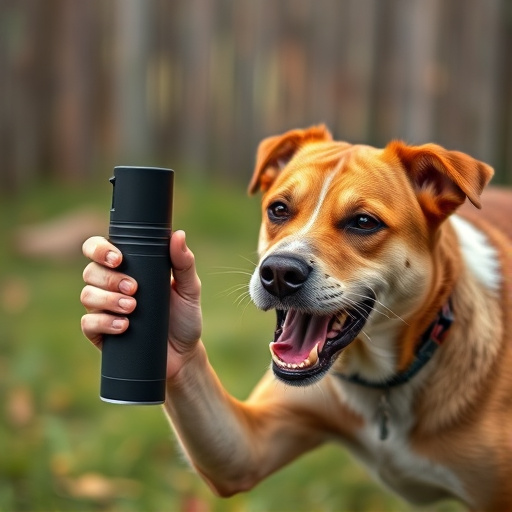Pepper spray, especially formulations with 1% to 2% capsaicin oil, is a safe and effective tool for managing aggressive dog behavior. Its unique chemical composition temporarily disorients dogs by irritating their eyes, nose, and throat, providing handlers with control or retreat time. Balancing potency and safety, these products are valuable in training, handling, and safeguarding against potential attacks. However, pepper spray is not a universal solution; responsible use, proper training, and exhausting non-lethal methods before deployment are crucial. Safety, suitable formulation, and targeted application are key to effective and safe deterrence of aggressive dogs.
“Discover the power of pepper spray as a non-lethal deterrent for aggressive dogs with our comprehensive guide. We explore the science behind its formulation, focusing on ingredients and efficacy, to ensure effective protection without harm. Learn how these innovative sprays work, from repelling canine intruders to maintaining safety during encounters. This article covers best practices and safety considerations, empowering you to handle dog control situations confidently while employing modern pepper spray formulations.”
- Understanding Pepper Spray for Dog Control: Ingredients and Efficacy
- The Science Behind Pepper Spray Formulations in Repelling Dogs
- Safety Considerations and Best Practices for Using Pepper Spray on Aggressive Dogs
Understanding Pepper Spray for Dog Control: Ingredients and Efficacy
Pepper spray, also known as capsaicin spray, is a non-lethal self-defense tool that has gained popularity for dog control due to its effectiveness in managing aggressive canine behavior. The active ingredient in pepper spray is capsaicin, a compound derived from chili peppers. This chemical irritates the eyes and respiratory system of dogs, causing them to temporarily become immobilized and distracted, providing an opportunity for handlers to gain control or retreat safely.
The formulation of pepper spray for dog control is carefully designed to balance potency and safety. It typically contains a specific concentration of capsaicin oil, which is usually between 1% and 2%. This concentration ensures that the spray is potent enough to deter aggressive dogs but safe enough for use around humans and other animals with minimal risk of serious harm or long-term effects. The spray’s ability to quickly disrupt a dog’s behavior makes it a valuable tool in training, handling, and protecting against potential attacks.
The Science Behind Pepper Spray Formulations in Repelling Dogs
The effectiveness of pepper spray formulations in repelling dogs, especially aggressive ones, lies in their unique chemical composition. These sprays contain capsaicin, a natural compound found in chili peppers, which is the key ingredient responsible for the stinging sensation it causes. When used against dogs, capsaicin irritates the animal’s eyes, nose, and throat, temporarily disorienting them and prompting a retreat. The science behind these formulations focuses on balancing potency with safety, ensuring that the spray is potent enough to deter aggressive behavior but not harmful to humans or other animals when used properly.
Research has shown that specific pepper spray formulations designed for dog repellency have a higher concentration of capsaicin, making them more potent than traditional personal defense sprays. Additionally, these products often incorporate other ingredients like natural oils and preservatives to enhance their effectiveness and prolong shelf life. The goal is to create a safe, non-lethal solution that can quickly de-escalate potentially dangerous situations involving aggressive dogs, making it an essential tool for animal control professionals and pet owners alike.
Safety Considerations and Best Practices for Using Pepper Spray on Aggressive Dogs
When considering pepper spray as a deterrent for aggressive dogs, safety should always be the top priority. It’s crucial to understand that pepper spray is not a cure-all solution but can be an effective tool when used responsibly. The formulation of the pepper spray matters significantly; it should be specifically designed for animal control, with controlled capsaicin levels suitable for canine use without causing severe or permanent harm. Users must receive proper training on its application to ensure they employ the correct technique, minimizing risks to themselves and others nearby.
Best practices dictate that pepper spray should only be deployed as a last resort when other non-lethal methods have failed. It’s essential to maintain a safe distance from the dog and aim for areas like the face, eyes, or nose, which can temporarily incapacitate without causing lasting damage. Users should also be prepared for potential backlash from the dog and have an escape plan in place. Regular maintenance and storage of the spray unit are critical to ensure its effectiveness and longevity.
Pepper spray, as a non-lethal option, offers an effective solution for managing aggressive dog behavior. Understanding its formulation and active ingredients is key to ensuring safety and efficacy. By adhering to best practices, owners can confidently use pepper spray as a last resort when traditional training methods fail. Armed with knowledge, responsible dog owners can navigate interactions with potentially dangerous dogs while prioritizing both animal and human safety.
